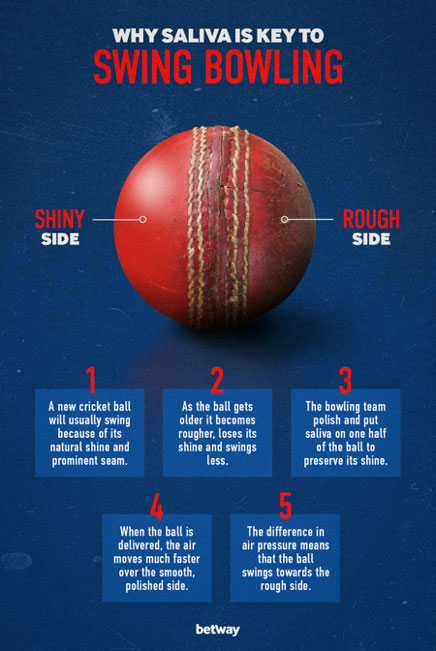Covid-19 has changed the world as its effect involves every activity the public takes part in. From shopping to eating out to watching one’s favorite sport, the pandemic has left its impression everywhere.
It is no secret that the world of sports has faced some major complications too. International sports authorities canceled multiple events and are still looking for ways to revive every sport in the best way possible.
Cricket, with approximately 2.5 billion fans around the world is the second most popular sport in the world, with football taking the first position. Covid-19 has put an end to the familiar sight of bowlers licking their fingers before swinging a ball as the International Cricket Council (ICC) has banned the use of saliva. The restriction on this traditional practice is temporary. It came into effect after the medical committee of the ICC recommended it in the wake of infection spreading through saliva.
Why is the use of saliva considered as an integral practice?
Sports enthusiasts who are not familiar with cricket tend to find it ridiculous that the ball has so much prominence. Even regular cricket watchers might not understand why the saliva ban is birthing so many discussions.
Bowlers use saliva to polish one side of the ball to enable it to swing well. The ball will thus have a shiny side and a rough side. Since the air moves fast over the smooth side, the swing happens. Based on the basic theory that altering the aerodynamic helps in movement, the practice of using saliva became very common. Bowlers achieve the ‘conventional’ swing by bowling with the polished side towards the batsman. The reverse swing happens when the rough side is facing the batsman, causing a delivery to swing in towards them (an in swinger), when one is expecting the ball to swing outwards (an out swinger). Older balls work better for a reverse swing, as they tend to be rougher.
The spit technique has undoubtedly created quite many magical moments in the game, awing its fans and garnering love from occasional watchers. By enforcing a temporary ban on the use of saliva, ICC has confused many bowlers on how to shine the ball and create that perfect swing. Australian pace bowler Mitchell Starc has opined that the batsmen might find it too easy to encounter balls with less movement. He fears that children who grow up watching this might not want to become bowlers.

Credits to Betway for the above infographic
The history of ‘polishing’ the ball
It is easy to note the several incidents that are highlighted throughout the history of cricket that is associated with the players’ struggle to ‘shine’ the ball. This involves a list of controversies and allegations of tampering the ball. Law 41, which comes under subsection 3 of the Laws of Cricket clearly states that it is legal to polish the ball, but without any artificial substances. Activities that involve damaging the seam of the ball or using a sharp object like a finger-nail to rasp the ball are considered offenses. Cricket players were creative in trying to polish the ball like these allegations and incidents show:
- English cricketer Ken Palmer was considered as a legend in seam picking one-handedly.
- During the England tour of Indian in 1976-77, Bish Bedi, the then-Indian Captain accused English cricketer John Lever of using Vaseline to polish the ball and boost its swing.
- In 1990, New Zealand players admitted that they had used bottle caps to help them alter the ball’s condition in Faisalabad. Pakistani cricketer Imran Khan has also stated that he had resorted to a similar method.
- Former England Captain, Mike Atherton was caught up in a ‘dirt in the pocket’ issue, as he was caught taking dirt from his pocket to rub the ball with, back in 1994 during a test match against South Africa.
- Marcus Trescothick, another English cricketer was (in) famous for using mints to help him get a better swing in the 2005 Ashes series.
Alternatives to the use of saliva
The ban of saliva turned everyone’s attention towards another body fluid, sweat! There is no evidence that perspiration can help in transmitting Covid-19. Therefore, it stands as the closest option to the spit-method. The problem here is a few droplets of perspiration on the players’ foreheads might prove to be less than what is required to polish the ball well.
Dukes, the reputed ball manufacturer has stated that hand-stitched balls and those which have a strong seam and good shape are swing-friendly. Another advice the Dilip Jajodia, the owner of Dukes shared with The Guardian was to use natural material like a cotton towel, and not the polyester kit. Since leather is used to make balls, natural materials work better with it. There have been discussions about using artificial wax also, as the cricket fraternity fears the inability to swing effectively can affect the thrill of the sport.
Conclusion
While there have been many cases in the history of cricket where the ball was tampered with to swing it perfectly, spit polishing was legal and the most-used method accepted by bowlers around the world.
Former cricket players like Deep Dasgupta (former Indian wicketkeeper) do not think that any other measure can prove to be as efficient as the use of saliva. This is also because it is an age-old practice and has fed the muscle memory of cricket players of several generations.
Although bowlers do not have any choice than to forgo the spit-polishing strategy, it makes the game more hygienic in nature and not a “vector of disease” as said by the UK Prime Minister, Boris Johnson. This move by ICC had launched multiple discussions on the topic to ensure that the nature of the sport does not have any impact.
Hopefully, as the world returns to normal the ban will be lifted too, bringing back the saliva trick that has ‘swung’ the game well too!

Loves all things female cricket
